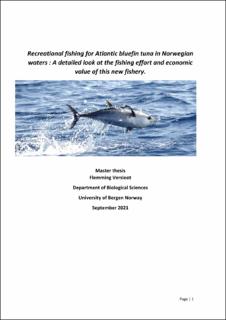| dc.description.abstract | Recreational fishing is a popular hobby and ecosystem service around the world, yet the impact of recreational fishing on both fish populations and local economies is often overlooked. This thesis will look at the fishing effort and economic value of recreational fishing for Atlantic bluefin tuna (Thunnus thynnus), a fish species that has only recently returned to Norwegian waters. In 2020, recreational bluefin tuna anglers got a license to fish and were involved in a citizen-based science project in collaboration with the Institute of Marine Research in Norway. A total of 24 fishing teams took part in this project, in which they helped register valuable fishing data by maintaining a logbook of their bluefin tuna fishing trips. This data included the number of fishing trips, trip duration, fish caught, and fishing strategy used for fishing . The recreational fishermen also helped in tagging bluefin tuna for research purposes. As recreational fishing for bluefin tuna in Norway is relatively new, an economic off-site survey (online questionnaire) was run 6 months after the fishing season was over to estimate the economic value of this new fishery. This can highlight the importance of recreational bluefin tuna fishing for future fisheries management. Besides expenditures that the anglers were willing to make, the questionnaire also had several questions regarding efforts made by the fishermen to fish for bluefin tuna. A total of 19 bluefin tunas were caught by the recreational anglers in Norwegian waters in 2020, with 4 fish being the highest catch for an individual team. The 24 teams set out for 176 fishing trips, which lasted for a combined total of 1641 hours. The combined Catch per unit effort (CPUE) for the 2020 BFT season was 0.012 fish per hour. The most popular fishing strategy used by the fishermen was spreader-bars, which were used in 75% of all fishing trips. The minimum economic value of the 2020 recreational bluefin tuna fisheries was estimated at 6 952 167 NOK. This excludes the investment costs of buying a suitable fishing boat. When these investment costs are included the minimum economic value would be 41 261 167 NOK. Boat-owners spend considerably more money and effort on their hobby than non-boat owners. The recreational fishing for Atlantic bluefin tunas in Norwegian waters has expanded in 2021 both in terms of fishing quota and the amount of participating teams. The information in this thesis may be used as a valuable baseline for future studies on the recreational fishing for bluefin tunas in Norway. | |
